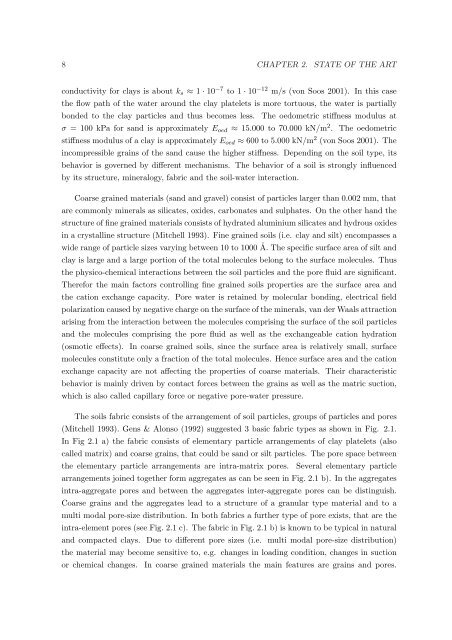Hydro-Mechanical Properties of an Unsaturated Frictional Material
Hydro-Mechanical Properties of an Unsaturated Frictional Material
Hydro-Mechanical Properties of an Unsaturated Frictional Material
Create successful ePaper yourself
Turn your PDF publications into a flip-book with our unique Google optimized e-Paper software.
8 CHAPTER 2. STATE OF THE ART<br />
conductivity for clays is about ks ≈ 1 · 10 −7 to 1 · 10 −12 m/s (von Soos 2001). In this case<br />
the flow path <strong>of</strong> the water around the clay platelets is more tortuous, the water is partially<br />
bonded to the clay particles <strong>an</strong>d thus becomes less. The oedometric stiffness modulus at<br />
σ = 100 kPa for s<strong>an</strong>d is approximately Eoed ≈ 15.000 to 70.000 kN/m 2 . The oedometric<br />
stiffness modulus <strong>of</strong> a clay is approximately Eoed ≈ 600 to 5.000 kN/m 2 (von Soos 2001). The<br />
incompressible grains <strong>of</strong> the s<strong>an</strong>d cause the higher stiffness. Depending on the soil type, its<br />
behavior is governed by different mech<strong>an</strong>isms. The behavior <strong>of</strong> a soil is strongly influenced<br />
by its structure, mineralogy, fabric <strong>an</strong>d the soil-water interaction.<br />
Coarse grained materials (s<strong>an</strong>d <strong>an</strong>d gravel) consist <strong>of</strong> particles larger th<strong>an</strong> 0.002 mm, that<br />
are commonly minerals as silicates, oxides, carbonates <strong>an</strong>d sulphates. On the other h<strong>an</strong>d the<br />
structure <strong>of</strong> fine grained materials consists <strong>of</strong> hydrated aluminium silicates <strong>an</strong>d hydrous oxides<br />
in a crystalline structure (Mitchell 1993). Fine grained soils (i.e. clay <strong>an</strong>d silt) encompasses a<br />
wide r<strong>an</strong>ge <strong>of</strong> particle sizes varying between 10 to 1000 ˚ A. The specific surface area <strong>of</strong> silt <strong>an</strong>d<br />
clay is large <strong>an</strong>d a large portion <strong>of</strong> the total molecules belong to the surface molecules. Thus<br />
the physico-chemical interactions between the soil particles <strong>an</strong>d the pore fluid are signific<strong>an</strong>t.<br />
Therefor the main factors controlling fine grained soils properties are the surface area <strong>an</strong>d<br />
the cation exch<strong>an</strong>ge capacity. Pore water is retained by molecular bonding, electrical field<br />
polarization caused by negative charge on the surface <strong>of</strong> the minerals, v<strong>an</strong> der Waals attraction<br />
arising from the interaction between the molecules comprising the surface <strong>of</strong> the soil particles<br />
<strong>an</strong>d the molecules comprising the pore fluid as well as the exch<strong>an</strong>geable cation hydration<br />
(osmotic effects). In coarse grained soils, since the surface area is relatively small, surface<br />
molecules constitute only a fraction <strong>of</strong> the total molecules. Hence surface area <strong>an</strong>d the cation<br />
exch<strong>an</strong>ge capacity are not affecting the properties <strong>of</strong> coarse materials. Their characteristic<br />
behavior is mainly driven by contact forces between the grains as well as the matric suction,<br />
which is also called capillary force or negative pore-water pressure.<br />
The soils fabric consists <strong>of</strong> the arr<strong>an</strong>gement <strong>of</strong> soil particles, groups <strong>of</strong> particles <strong>an</strong>d pores<br />
(Mitchell 1993). Gens & Alonso (1992) suggested 3 basic fabric types as shown in Fig. 2.1.<br />
In Fig 2.1 a) the fabric consists <strong>of</strong> elementary particle arr<strong>an</strong>gements <strong>of</strong> clay platelets (also<br />
called matrix) <strong>an</strong>d coarse grains, that could be s<strong>an</strong>d or silt particles. The pore space between<br />
the elementary particle arr<strong>an</strong>gements are intra-matrix pores. Several elementary particle<br />
arr<strong>an</strong>gements joined together form aggregates as c<strong>an</strong> be seen in Fig. 2.1 b). In the aggregates<br />
intra-aggregate pores <strong>an</strong>d between the aggregates inter-aggregate pores c<strong>an</strong> be distinguish.<br />
Coarse grains <strong>an</strong>d the aggregates lead to a structure <strong>of</strong> a gr<strong>an</strong>ular type material <strong>an</strong>d to a<br />
multi modal pore-size distribution. In both fabrics a further type <strong>of</strong> pore exists, that are the<br />
intra-element pores (see Fig. 2.1 c). The fabric in Fig. 2.1 b) is known to be typical in natural<br />
<strong>an</strong>d compacted clays. Due to different pore sizes (i.e. multi modal pore-size distribution)<br />
the material may become sensitive to, e.g. ch<strong>an</strong>ges in loading condition, ch<strong>an</strong>ges in suction<br />
or chemical ch<strong>an</strong>ges. In coarse grained materials the main features are grains <strong>an</strong>d pores.
















